
vacuum forming - A method of shaping a flat plastic
sheet over a solid relief pattern (also called
a male or positive mold).
The plastic is heated until it is soft, and when a vacuum is created
under the mold, the plastic is drawn down onto it, as if forming
a 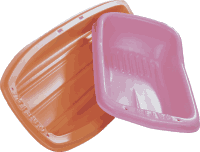 new skin. The plastic sheet cools quickly,
retaining the shape of the pattern. Vacuum forming is desirable
when needing a "shell" type plastic form with a uniform
thickness. A form can be made over molds made of wood, plaster, and many other materials.
Also see cast and impression.
new skin. The plastic sheet cools quickly,
retaining the shape of the pattern. Vacuum forming is desirable
when needing a "shell" type plastic form with a uniform
thickness. A form can be made over molds made of wood, plaster, and many other materials.
Also see cast and impression.
value key - The relative level of a color's value, whether referencing an individual color, or a color scheme seen either in an artwork's entirety or in a passage within one. The lighter the value, the higher and more cheerful the value key; the darker the value, the lower and more somber the value key.
Also see chroma key, contrast key, cool colors, tonal key, warm colors, and temperature key.
value scale - A gray scale, a series of spaces filled with the tints and shades of one color, starting with white or the lightest tint on one end, and gradually changing into the darkest shade or black on the other.
Examples:

A value scale in four values. A 2-bit image is capable of displaying four different values.

A value scale in eight values. A 3-bit image is capable of displaying eight different values.

A value scale in sixteen values. A 4-bit image is capable of displaying sixteen different values.
Other examples of value scales can be seen in the articles on gray scale and value. Also see gradation.
vandal, Vandals, vandalism, and vandalize - A vandal is a person who willfully or maliciously defaces or destroys public or private property.
The name comes down to us from the Vandals, a Germanic people who overran Gaul, Spain, and northern Africa in the fourth and fifth centuries CE. In 455 they sacked Rome, bringing an end to the classical period in European history, and ushering in the long period known by many as the Dark or Middle Ages. There were actually many other causes for the decay of Roman civilization, but the Vandals have popularly borne the greatest blame. Among the "barbarian tribes," this bunch was particularly notorious for wantonly destroying monuments of art and literature. The Vandals' wild strength was short-lived, however. By the middle of the sixth century their leadership had evaporated, and their population absorbed into the various peoples among whom they lived.
Ever since these ancient events, "vandalism" has been the preferred term for willful or malicious destruction of property. Similarly, "to vandalize" is to cause such destruction. Contemporary vandals are often perceived to be ignorant people, who maintain no interest in promoting or safeguarding civilization. Sadly, every community endures the effects of vandals on its citizens' art, architectural, and natural features.
It has not been unusual for participants in various avant-garde art movements to be criticized as vandals. Especially easy targets have been painters producing graffiti.
Example:
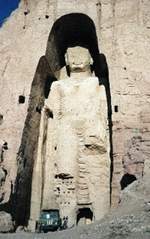
![]()
In the spring of 2000, Afghanistan's Taliban
(Islamic extremists in power) destroyed colossal statues of the Buddha, carved from
a living rock cliff at Bamiyan, 145 km west of Kabul, Afghanistan,
long before the arrival of Islam in that area. One of the statues
was 53 meters high and dated to the 5th century; the other was
37 meters tall and dated to the 3rd century. These were rare
examples of statuary in the Greco-Buddhist style, priceless ancient
relics of this important cultural crossroads. Several thousand
monks once lived in the caves next to the statue. The Taliban's
supreme leader, Mullah Mohammed Omar, ordered the destruction
in an edict, saying such images were contrary  to Islam.
"These idols have been gods of the infidels, who worshiped
them, and these are respected even now and perhaps maybe turned
into gods again," his edict said. Other resources on this
story: 1 and 2. (See Buddhist
art, Islamic
art, Islamism,
and xenophobia.)
to Islam.
"These idols have been gods of the infidels, who worshiped
them, and these are respected even now and perhaps maybe turned
into gods again," his edict said. Other resources on this
story: 1 and 2. (See Buddhist
art, Islamic
art, Islamism,
and xenophobia.)
Related link:
Also see creativity, iconomachy, iconophobia, iconophobiac, pornography, Roman art, and transgressive art.
vanishing point  - In linear
perspective, a position on a horizon
where lines
or rays between near and distant places appear to converge (come together). In order to produce an illusion of depth in a two-dimensional representation of space, artists sometimes use one, two, or more vanishing points. Employing this method might seem to contradict a strictly mathematical understanding of space: parallel lines — as might form the edges of a straight path — meet at the vanishing point in a picture of a distant place, even though such lines could not meet in the actual distance. Although an artist marks vanishing points in pictures to determine the directions of receding lines, s/he is apt to remove them before completing a picture, because vanishing points are merely points of reference. Where would a vanishing point be placed in a drawing of this railroad scene?
- In linear
perspective, a position on a horizon
where lines
or rays between near and distant places appear to converge (come together). In order to produce an illusion of depth in a two-dimensional representation of space, artists sometimes use one, two, or more vanishing points. Employing this method might seem to contradict a strictly mathematical understanding of space: parallel lines — as might form the edges of a straight path — meet at the vanishing point in a picture of a distant place, even though such lines could not meet in the actual distance. Although an artist marks vanishing points in pictures to determine the directions of receding lines, s/he is apt to remove them before completing a picture, because vanishing points are merely points of reference. Where would a vanishing point be placed in a drawing of this railroad scene?
When you see something getting farther and farther away from you, it appears to be smaller and smaller. If it continues to recede, it eventually disappears — vanishing. That sensation lies at the core of this term.
Thanks, Bonny Pickens, for your advice on this article. - MD
Internet resources concerned with vanishing point:
Also see erasure, focal point, one-point perspective, optical illusion, point, and two-point perspective.
variation, various, vary - To vary is to cause change, or to give variety or make diverse. Variation is the act, process, or result of varying; or it is the extent to which something varies: or the thing that varies. Various is the adjectival form describing several things as varying — being different.
Also see nuance and variegated.
variegated - Marked with patches, spots, or streaks of different colors. In contrast to a surface having either one color or a regular pattern or texture, a variegated surface has a varied design of several colors and / or textures. Often used in describing materials as as textiles, and parts of plants and animals.
(pr. VA-ree-ə-gay-təd)
Also see brindled, piebald, variation, various, variegated, variety, and vary.
variety - A principle of design that refers to a way of combining elements of art in involved ways to achieve intricate and complex relationships. Variety is often obtained through the use of diversity and change by artists who wish to increase the visual interest of their work. An artwork which makes use of many different hues, values, lines, textures, and shapes would reflect the artist's desire for variety. Unity is the principle which is its variety's opposite; but when there is too little variety, the result is monotony.
Quotations:
Also see comparison, harmony, horror vacui, interesting, tension, variation, various, variegated, vary, xenophilia, and xenophobia.
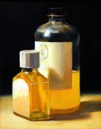
varnish - A protective transparent finish applied in a liquid state to a surface. One example is glair — a varnish for tempera paint. Many are available with a matte, semi-gloss, or glossy finish.
Related link:
Also see acrylic and oil paint, medium, pigment, polymer, polyurethane, resin, shellac, stain, stain removal, wood, and xylene.
vary - See variation.

vault - In architecture, an arched roof or covering of masonry construction — made of brick, stone, or concrete. A barrel (or tunnel) vault is semi-cylindrical in cross-section, made up of a continuous row of arches joined to one another. A groin or cross vault consists of two barrel vaults intersecting each other at right angles. In a cross-barrel vault, the main barrel (tunnel) vault is intersected at right angles with other barrel (tunnel) vaults at regular intervals. A dome is a hemispherical vault. A quadrant vault is a half-barrel (tunnel) vault. In a ribbed vault, there is a framework of ribs or arches under the intersections of the vaulting sections.
A sexpartite vault is a ribbed vault with six panels. A fan vault is a development of lierne vaulting characteristic English Perpendicular Gothic, in which radiating ribs form a fan-like pattern.
Example:
Hieronymus Rodler (German, d. 1539), Zu eynem Gewelb/so du off die art haben willt . . . (A vault the way you'd like it),1531, woodcut, 8 1/2 x 5 5/8 inches, from Hieronymus Rodler, Eyn schön nützlich Büchlin vnd Vnderweisung der Kunst des Messens mit dem Zirckel. Siemeren, 1531, leaf D2, Getty Research Institute, Malibu, CA. This vault image demonstrates the virtues of linear perspective.

Three alternating views of a rib
vault in an unidentified Gothic cathedral.
Related link:
The Glossary of Medieval Art and Architecture defines several types of rib vaults: fan, net, quadripartite, sexpartite; as well as the barrel or tunnel vault, and the groin vault; and provides illustrations.
Also see aisle, centering, clerestory, crocket, Gothic, Middle Ages, nave, ogive, pendentive, perpendicular, rib, trabeation, and triforium.
VE - Abbreviation for the print term, variable edition.
vector graphic - A digital image encoded as formulas that represent lines and curves. The alternative and older means of encoding images is bitmapping. Vector graphics use mathematical functions to create all shapes. File sizes are a lot smaller with vector graphics than with bitmap images because less information has to be stored. Vector graphics can be reduced and enlarged (zoomed in and out) with no loss of resolution.
One of the main issues that concern web designers is the need to keep the file size of an image small which in turn impacts bandwidth. Most images on the web are bitmaps — typically JPEGs and GIFs. The bits and bytes generating bitmap images must be stored pixel by pixel. Macromedia Flash is the web standard for vector graphics and animation, because it is easy to use without scripting.
Related link:
Also see wireframe.
vehicle - In the visual arts, that which carries a paint's pigments, and is also called a medium or a base. The vehicle is what determines what kind of paint is produced. A painter can mix a vehicle with its solvents, pigments and other substances in order to make paint (or dye or ink) and control its consistency. A variety of vehicles are available that provide a matte, semi-gloss, or glossy finish. Just as motorized vehicles move us around on our planet, think of these substances as moving pigments around on various supports.
| vehicle | paint |
|---|---|
| linseed oil | oil paint |
| gum arabic | watercolor |
| gum arabic | gouache |
| casein (milk-glue) | casein |
| egg-yolk | egg tempera |
| gum triganth | student tempera |
| beeswax or other waxes | encaustic |
| fresco | plaster |
Be careful not to confuse "vehicle" with " solvent." Thanks to Julie Shaw at BCC in Chico!
Also see binder, casein, gouache, tempera, miscible, solvent, turpentine, viscosity, watercolors, water-soluble, and wetting agent.
Velcro ® - An adhesive
of sorts, a trademark for
a fastener consisting of two pieces of fabric, one with a dense
layer of hooks and the other with loops, often used on outerwear,
shoes, and luggage. ![]()
 The name comes from the combination of
two French words "velour" and "crochet". Velcro
works best when it is used on objects
that have two sides to join
— not very strongly, and need occasionally to be re-opened.
The name comes from the combination of
two French words "velour" and "crochet". Velcro
works best when it is used on objects
that have two sides to join
— not very strongly, and need occasionally to be re-opened.
A magnified view of the loop and hook sides
of Velcro.
Velcro was invented in 1948 by George de Mestral (1907-1990), a Swiss engineer. The idea came to him after noticing burrs sticking to his dog and to his pants legs after hikes in the Alps. The name Velcro is a registered trademark. Similar, generic manufactures often use the name "hook and loop" or "touch fasteners." Now there are hundreds of different hook and loop products and fastening systems. They range from standard fastening tapes of woven and knit construction, through custom-designed specialty fasteners featuring a range of performance characteristics, materials, sizes, and shapes.
After a few months of use, Velcro can accumulate larger hairy dust and fur in the hook side, making the system less effective.
The strength of a Velcro bond depends on how much surface area is in contact with the Velcro hooks. Full-body Velcro suits have been made that can hold a person to a Velcro-covered wall.
When the sides are opened, the Velcro makes a telltale ripping sound. The US Army asked the Velcro corporation to develop a silent version of Velcro for use on soldiers' uniforms.
Alternatives to Velcro are buttons, snaps, zippers, laces, hook-and-eye, and buckles. Other alternatives might be rubber bands, twist-ties, safety pins, and adhesive tape.
Related link:
vellum - Fine parchment, originally calf-skin, used traditionally for manuscripts.
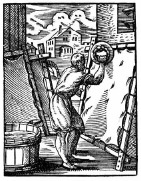
German, How Vellum is Produced, 16th century,
woodcut. A man scrapes one of
several hides which have been stretched on wooden
frames.
An example of another use of vellum:

Carlo Bugatti (Italian, 1855 or 56-1940),
Cobra
Chair, 1902, vellum, wood,
copper, crayon,
and paint, Carnegie Museum
of Art, Pittsburgh, PA. See furniture.
Related link:
Also see illustration board, incunabulum, oaktag and paper.
veneer - The thin slice of a material
— often of a rare and expensive material — applied, generally
with an adhesive, but also
(and sometimes only) with pins, to a surface of a 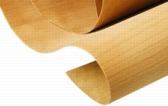 humbler material.
Ebony, rosewood, tulipwood and other exotic woods are more often used as veneers in furniture-making than they are
used in a solid form. Most wood veneer is sliced rather than sawn,
and taken from a log in a continuously spiraling (voluting) cut, and then flattened.
Because of concern that such veneer may be more likely to curl
away from its placement, some feel that flatly sawn veneer is
preferable. Sawn veneer however, because the saw destroys as much
wood as the veneer it produces, is much more expensive. Brass, copper, ivory, mother-of-pearl, pewter,
and tortoiseshell can also
be used and are often combined with such woods. Semi-precious stones such as lapis
lazuli and malachite (also used for inlay)
are sometimes employed as a veneer, as are the more showy types
of calcite alabaster.
Veneering is more easily achieved on a flat surface, but thin slices of wood can be bent, for example into
the hollow of a molding.
Stone cannot be bent, so its veneering on curved or complex forms is particularly difficult. There
are plastic sheet materials
also called veneers, many simulating other materials, such as bricks, stone, lap siding, shingles,
etc.
humbler material.
Ebony, rosewood, tulipwood and other exotic woods are more often used as veneers in furniture-making than they are
used in a solid form. Most wood veneer is sliced rather than sawn,
and taken from a log in a continuously spiraling (voluting) cut, and then flattened.
Because of concern that such veneer may be more likely to curl
away from its placement, some feel that flatly sawn veneer is
preferable. Sawn veneer however, because the saw destroys as much
wood as the veneer it produces, is much more expensive. Brass, copper, ivory, mother-of-pearl, pewter,
and tortoiseshell can also
be used and are often combined with such woods. Semi-precious stones such as lapis
lazuli and malachite (also used for inlay)
are sometimes employed as a veneer, as are the more showy types
of calcite alabaster.
Veneering is more easily achieved on a flat surface, but thin slices of wood can be bent, for example into
the hollow of a molding.
Stone cannot be bent, so its veneering on curved or complex forms is particularly difficult. There
are plastic sheet materials
also called veneers, many simulating other materials, such as bricks, stone, lap siding, shingles,
etc.
(pr. və-NEER)
Also see basket, cladding, intarsia, laminate, marquetry, mosaic, and parquetry.
Venice turpentine - Canada balsam, an oily resin or balsam obtained from conifers. Also see turpentine.
verdigris - A particular green pigment.
Related resource:
verisimilitude - Appearing to be true or real.
See appearance, cinema, copy, counterfeit, fake, forgery, likeness, mirror, realism, reflection, reification, representation, simulacrum, simulation, theater, trompe l'oeil, virtual, and virtual reality.
vermicular - Shaped or moving like a vermicule, which is a worm; worm-like.
(pr. vr-mi'kyoo-lr)
vermiculite - A product commonly used by gardeners, who mix it into soil in order to aerate the soil. Vermiculite is sometimes mixed into plaster as an aggregate to make plaster easier to carve, and to give it a pleasing texture. An alternative softening aggregate, also found in garden supply stores, is a white product called perlite.
(pr. vər-MI-kyə-li:t)
vermilion - A particular red pigment.
Related resource:
Also see antimony.
vernacular - The standard native language of an area. May also refer to architecture, furniture, or some other art or craft of a region, culture, or period. Vernacular architecture and furniture is made in local rather than cosmopolitan traditions of design and construction, reflecting the needs of ordinary people's lives.
(pr. vər-NA-kyə-lər)
Also see folk art.
vernissage - A private showing, preview, or opening of an art
exhibition — an event marking
the start of an exhibition. This word was used with increasing
frequency in the United States in the last decade of the 20th
century. Vernissage has its roots in the old
![]()

![]()
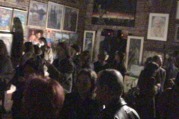
(pr. VAYR-nə-SAHZH)
verso - The second or back side of any work on paper. May also be the left-hand page of a book. The opposite of recto. The front and rear sides of other two-sided objects, such as coins, medals, or panels which have a painting on each side are more often referred to as obverse and reverse.
Example:
![]()

![]()
American, verso of a photo of a building,
Denver, Colorado, c. 1890, Denver Public Library.
Also see numismatics and printing.
vertex - The highest point; the apex or summit. The point at which the sides of an angle intersect. The point on a triangle or pyramid opposite to and farthest away from its base. A point on a polyhedron common to three or more sides. The plural form can be either vertexes or vertices.
Also see polygon and protractor.
vertical - The direction going straight up and down; the opposite of (or perpendicular to) horizontal. Any orientation neither vertical nor horizontal is diagonal. A vertical sculpture is taller than it is wide. Portraits are conventionally vertical in their orientation, while landscapes are most often horizontal.
Examples of notably vertical works:

Charles Rennie Mackintosh (Scottish, 1868-1928),
designer, Hill House Chair, 1904, black lacquered
wood with upholstered
seat, 55 x 16 x 14 1/4 inches. See Arts
and Crafts Movement.

Henri Matisse (French, 1869-1954), Porte-fenêtre à Collioure (Window
Swung Open at Collioure), 1914, oil
on canvas, 116.5 x 89 cm,
Georges Pompidou Center, Paris.

Constantin Brancusi (French, born Romania,
1876-1957), Endless Column, 1937-38, metal-coated
cast-iron modules
on a steel spine, height 98 feet, Târgu-Jiu,
Romania. It was restored and reassembled in 2000, as seen here.
Endless Column is one of three elements in a sculptural
ensemble. the other two works are the travertine Table of
Silence and the Gate of the Kiss. The Endless Column
was conceived as a monument
to young Romanians who died in World War I. See column.

John Steuart Curry (American, 1897-1946),
Fire Diver, 1934, watercolor on paper
mounted on board, 22 1/2
x 15 1/2 inches, Kemper Museum of Contemporary Art, Kansas City,
MO. See movement.

Ralston Crawford (American, 1906-1978), Turbine Shafts, Coulee Dam #2, 1971,
oil on canvas,
20 x 30 inches, Kemper Museum of Contemporary Art, Kansas City,
MO. See Precisionism and technology.
|
In graphics software, to make the following change is to
"flip vertically"
|
Also see align and alignment, statue, and zip.
Very Special Arts - The former name of VSA arts.
vexillology - The study of flags.
vicesimo-quarto - A book or manuscript of the next size smaller than an sextodecimo. Sextodecimo is abbreviated 24mo, sometimes pronounced "twentyfour-mo." The next smaller size is tricesimo-segundo.
Also see bookbinding, duodecimo, folio, octavo, quarto, and signature.
video digitizer - An image-capture device that employs a digital camera attached to a circuit board in a computer which converts the video signal into a digital file.
Also called a frame-grabber.
videodisc - An optical disk storage medium for images, still or moving. It is sometimes called laser viseodisc, and can store 108,000 still images per disc.
Also see CD-ROM and new media.
Vienna Secession - See secession.
Vietnamese art -
Example:
![]()

![]()
Nguyen Thu (Vietnamese, contemporary), Thao, 1955, watercolor, British Museum, London.
viewer - A person who gazes; an onlooker or spectator. Sometimes used as a synonym for audience. Also, any of many possible optical devices used in viewing something, especially photographic transparencies such as slides, by illuminating and magnifying them.
Also see interpretation, patron, theater, and voyeur.
viewfinder - A small window cut in a piece of paper or card, that shows what will be in a picture's composition. Or, a window seen through a camera which shows an approximation of a picture the camera would photograph Viewfinders assist in making compositions. This is a fundamental sort of optical device.
Examples:

Here is a viewfinder for an artist who wishes
to "find" a view for a composition. A watch lies beside it to give
us the viewfinder's scale.
This viewfinder is adjustable. It is made of two L-shaped pieces
of card held in position
by two paperclips. These allow the viewfinder's aperture
to be changed in size and
in the ratio of its height
to its width.

This filmmaker is using another kind of viewfinder
in order to determine the composition of her next shot. A 19th
century precursor to this device was the iconometer.
![]()
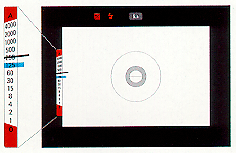
![]()
The viewfinder of a Nikon 35 mm single-lens-reflex
model FM3a, 2003.
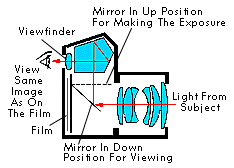
This cutaway diagram
of 35 mm SLR shows how it allows a photographer to preview a
shot. A mirror conveys the image passing through the lens to
the viewfinder. This is the same image that will be taken when
the film is exposed to it.
![]()

![]()
A small LCD-type viewfinder for a video camera,
c. 2002.
viewing stones - See suiseki.
vignette - A decorative design placed at breaks in an article, at the beginning or end of a book or chapter of a book, or along the border of a page. Sometimes, an unbordered picture, often a portrait the edges of which fade off or blur into the color of its surrounding area.
(pr. vin-YET)
An example of a vignette incorporated within a painting:

Gerard David (Netherlandish, born about 1455,
died
 1523), The Rest on the Flight into Egypt, c.
1512-15, oil on wood
panel, 20 x 17 inches (50.8 x 43.2
cm), Metropolitan Museum of Art, NY. The inclusion of a
1523), The Rest on the Flight into Egypt, c.
1512-15, oil on wood
panel, 20 x 17 inches (50.8 x 43.2
cm), Metropolitan Museum of Art, NY. The inclusion of a vignette
of the Holy Family emerging from the forest allows this painting to provide a continuous narrative.
See chiaroscuro, drapery,
and Northern
Renaissance.
Also see baby spot, clip art, dingbat, glyph, and thumbnail sketch or thumbnail image.
viridian - A particular green pigment.
Related resource:
virtual - Existing not in actual fact or form, but in essence or effect in the mind, especially as a product of the imagination or of illusion. Also see mirror, new media, simulation, truth, universal artwork, virtual museum, virtual reality, and visualize.
virtual museum - [working on a definition]
Other resources concerning virtual museum:
Also see museum, new media, simulation, and virtual.
virtual reality - An interactive computerized simulation or synthesis of an experience in several senses.
Also see likeness, realism, reification, representation, simulacrum, theater, truth, universal artwork, and virtual.
virtuosity - The seemingly effortless skill or style employed by a virtuoso, or master.
(pr. VəR-choo-AH-sə-tee)
Also see craftsmanship, inspiration, masterpiece, talent, and technique.
virtuoso - Someone skilled in or having a taste for the fine arts, or someone who excels in the technique of an art (most commonly a highly skilled musician); a master. Also, a person who has great skill at some endeavor. English speakers borrowed "virtuoso" from Italian in the 17th century. In Italian, it can either be a noun or an adjective, the latter meaning both "virtuous" and "skilled." In English, the first virtuosos were men of substantial knowledge and learning. The word was then transferred to those skilled in the arts, and by the 18th century it had acquired its specific sense applied to musical performers. In the 20th century, English speakers broadened "virtuoso" again to apply to a person skilled in any pursuit. English speakers pluralize it as either "virtuosos" or "virtuosi."
(pr. VER-choo-OH-so or vər-choo-OH-zoh)
Also see craftsmanship, talent, and virtuosity.
viscosity - The relative resistance of a liquid to stirring or movement, and its stickiness. The thicker it is the greater is its viscosity; the thinner it is the lesser is its viscosity. Also see aqueous, caustic, clean up, consistency, hazardous, hot glue, solvent, vehicle, volatile, water-soluble, and wetting agent.
Vishnu - In Hindu belief, one of the principle deities, worshiped as the protector and preserver of worlds, who guards the equilibrium between good and evil. Vishnu descends to earth in the form or incarnation which is best suited to a situation. In the form of a human lion Vishnu saved a pious prince who was about to be murdered by his own father. Vishnu concealed himself in a column at the king's palace. And just when the king was about to strike — to punish his son for his faith in Vishnu — the god appeared out of the column and tore the king to shreds. Vishnu took on the incarnation of a boar to save the world which the water demon had inundated with the ocean. The boar lifted the earth — generally personified as a woman — from the bottom of the ocean. Vishnu is often conceived as a member of the triad including Brahma and Shiva.
Also see Ganesha and Ramayana.
vision - See seeing.
visual culture - A term used more and more in art education, which refers to what we have otherwise called art, but it is more inclusive and less likely to rely upon value judgments. Visual culture includes imagery in all kinds of media, in electronic games, in sports, cosmetics (and other fashion-related settings), comic books, politics, in imagery associated with holidays and terrorism. It can be said to include all or nearly all of what people experience visually. Certain works that a Eurocentric audience might call art, but are not called art by the cultures that produced them can be included in discussions of visual culture, yet they may not have been included in discussions of art. Examples of such work might include kachina dolls, bonsai, and boomerangs. A related term (some would say a synonym) is material culture. Proponents often assert that the study of visual culture promotes visuality and reflexivity and empowers students concerning social issues.
Quote:
In the field of art education, visual culture is "a range of all material objects in the environment and has expanded to the performance and virtual images. The aim is to provide students with a set of critical tools for the investigation of human visuality, not to transmit a specific body of information or values.”
Paul Duncum, and T. Bracey, (Eds.). (2001). On knowing: Art and visual culture. Christchurch, New Zealand: Canterbury University Press: University of Canterbury, p. 210.
Also see intertextuality.
visuality - The process of sighting or looking that is more purposeful, critical, and direction-oriented than seeing.
Also see reflexivity and visual culture.
visualize - To see or form a mental picture of something. Descriptive language that produces visualization is called ekphrasis.
Quote:
See brainstorming, choose, creativity, design, effort, motivation, plan, and projection principle.
visual qualities - The careful arrangement of the elements and principles of design in a work of art. This aesthetic quality is favored by formalism.
Also see art, artist, composition, definition, gestalt, optical, optical mixing, perception, seeing, and weight.
visual scale - The size or proportion (scale) of elements or components of art or of architecture — relative to the perceived sizes of other such works or objects of known or assumed size.
Also see dimensions, full-scale, human scale, iconometer, and mechanical scale.
vitreous humor - Physically essential to sight, a clear, jelly-like fluid found in the back of the eye that maintains the shape of the eye.
Related resources:
Also see aqueous humor, lens, ophthalmology, optical, perception, pupil, and retina.
vitrify - To change materials into glass or a glass-like substance through heat fusion. This is the action of a kiln heating ceramic clay and glazes, for instance. A curious example: lightning striking a metal rod partly buried in sand will cause all the sand within a certain distance from the rod to vitrify.
Also see firing.
vitrine - A largely transparent cabinet or case in which an exhibitor can place one or more objects so that viewers may see them. Much as frames both set off and protect two-dimensional works, vitrines are display furniture, designed to set apart and to protect their contents. Most are effectively boxes whose sides are panels of clear glass or plastic. Some are also fitted with lamps providing artificial light. Some have sensors that can trigger alarms. And some are outfitted to maintain a desirable atmosphere. There are very small vitrines, even for single objects, but some three-dimensional objects might be better displayed in a shadow box.
(pr. və-TREEN)
Examples:

Here are two contemporary
mass-produced vitrines. The one standing on the floor has four
glass shelves and is 7 feet tall.
The one mounted on a wall
has three shelves.
Also see base, bin, Kunstkabinett, Kunstkammer, niche, pedestal, preparator, Wunderkabinett, and Wunderkammern.
![]()
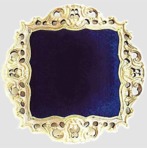
![]()
void - Containing no matter, empty, negative space.
Examples:

Henry Moore (English, 1898-1986), sculpture, bronze, Art Gallery of Ontario, Toronto,
Canada.
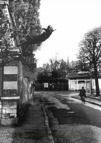
Yves Klein (French, 1928-1962), Leap into
the Void, 1960, photomontage,
silver gelatin print, 350 x 270 mm. This photograph
shows Klein falling from a wall toward the pavement of a Parisian
street. Producing the picture
at the time of the first
human travels beyond earth's atmosphere, Klein was alluding to
the human bodys' altered relationship to the cosmos.
Also see concave, heraldry, lacuna, shard, and subtractive.
volatile - Rapidly evaporating (as are many solvents). Or, tending to vary often or widely; inconstant. Or, capable of quickly becoming violent.
(pr. VAH-lə-təl)
Also see ASTM International (American Society for Testing and Materials), caustic, clean up, hazardous, Material Safety Data Sheet (MSDS), miscible, viscosity, and water-soluble.
![]()
![]()

![]()
volume - Refers to the space within a form. Thus, in architecture, volume refers to the space within a building.
Also see chiaroscuro and mass.
volunteers - Museums depend on lots of people to donate their time to perform many jobs in the museum — docents for instance.
Vorticism - A short-lived modernist English art movement founded in 1914 by painter Wyndam Lewis (English, 1882-1957), along with poet Ezra Pound (American, 1885-1972), who devised the group's name. To him the vortex represented "the point of maximum energy," which he saw as the essential characteristic of modern life. Vorticism was related to Cubism and Futurism, and like those movements, its momentum was greatly depleted by World War I (1914-1919). While Futurism's imagery typically involved blurred movement, Vorticism's centered on hard edges and angles, as seen in Cubism, here applied to powerful machinery and massive structures.
Examples:

Lawrence Atkinson (English, 1873-1931), The Lake, c. 1915-20, pen
and watercolor
on paper, 25.4 x 36.8 cm, Tate Gallery,
London.

Wyndham Lewis (English, 1882-1957), Planners: Happy Day, 1912-3, pen,
gouache and pencil
on paper, 31.1 x 38.1 cm, Tate Gallery,
London.

Wyndham Lewis, Composition, 1913, pen,
watercolor
and pencil on paper,
34.3 x 26.7 cm, Tate Gallery, London.

Wyndham Lewis, Workshop c. 1914-5, oil
on canvas, 76.5 x 61.0 cm,
Tate Gallery, London.

Wyndham Lewis, The Crowd, exhibited
1915, oil and pencil
on canvas, 200.7 x 153.7 cm,
Tate Gallery, London.

Wyndham Lewis, Ezra Pound, 1939, oil
on canvas, 76.2 x 101.6 cm,
Tate Gallery, London. Lewis produced this portrait many years
after Vorticism had faded away. It was American poet Ezra Pound
who coined the name "Vorticism." In 1914, he and Wyndham
Lewis began the promotion of Vorticism as an avant-garde
art movement celebrating
the machine age and the artist as a mystic, inventor, and organiser
of forms.
![]()
Henri Gaudier-Brzeska (English, born France,
1891-1915), The Imp, c. 1914, alabaster, 40.6 x 8.9 x 8.3 cm, Tate Gallery,
London. The Imp shows the influence of Gaudier-Brzeska's
study of fetishes. Its almost
phallic form reflects a commonly held association between the
'primitive' and an energising
sexuality. In 1914, Gaudier-Brzeska
wrote in Blast in praise of
the fetishes and love charms
of Africa and
Oceania as masterpieces that emerged from a 'vortex of fecundity'.
The contemplation of sexuality, he claimed, provided 'great energy'.
votive, votary - A votive object or votary is an object which expresses or symbolizes a wish, prayer, or vow. Votive pictures and sculptures, for instance, are intended to inspire devotion to a saint or deity, or are used in an act of religious worship, reverence, or supplication. It may also refer, for example, to certain candles, prayer cards, or offerings.
(pr. VOH-təv, VOH-tə-ree)
Examples:
Syro-Hittite, 2000 - 1700 BCE, Figurine, cast clay, 5 3/4 x 1 3/4 inches (14.8 x 4.6 cm), Michael C. Carlos Museum, Emery U, Atlanta, GA. This figure was probably meant for magic rituals, and may have been used as a votive offering related to fertility. Fertility was an essential concept in the life of ancient societies, and all the different aspects of religion and culture were oriented towards promoting it. For people depending on agriculture, survival was not only based on the fecundity of the human mother but also on the fruitfulness of the land.
Greece, from Olympia, c. 750-700 BCE, Statuette of a Horse, Geometric Period, bronze, Michael C. Carlos Museum, Emery U, Atlanta, GA. Such bronze statuettes were most often dedicated in sanctuaries as votive offerings. A figurine much like this one appeared in the movie "Black Stallion," and was called Bucephalus. See Greek art.
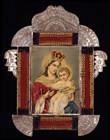
"The Isleta Tin Smith," New Mexican
santero, Madonna and Child, cut and pierced tin, paper
and reverse painted glass,
c. 1900, Millicent Rogers Museum, Taos, NM. See Madonna and santo.
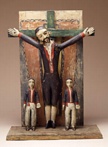
Unknown Hispanic New Mexican santero,
San
Acacio, bulto, c. 1880, painted wood,
Millicent Rogers Museum, Taos, NM. See crucifix
and santo.
Also see charm, ex voto, icon, iconoduly, milagro, retablo, santero, santo, and talisman.
voussoirs - The wedge-shaped stones which form the curved portions of an arch or a vaulted ceiling. (pr. voo-swahr')
Related link:
Also see keystone.
voyeur, voyeurism - A voyeur is a person who is sexually excited by observing, especially secretly, people in sexual situations. By extension, a voyeur can also be a person who is obsessed with looking at sordid or sensational subjects. This word was borrowed from the French in the early 20th century. The French word voyeur literally means "one who sees," from voir "to see." Voyeurism is the practice of acting in this way. Voyeurism is considered a deviant sexual behavior in most cultures, is most frequently practiced by males, and is tolerated to some degree in certain societies depending upon the circumstances (e.g., adolescent "Peeping Toms").
(pr. voy-əR, VOY-ər-izm)
Also see audience, Dada, erotica and erotic art, fig leaf, First Amendment rights, gaze, gender issues, nude, obscenity, pornography, sensuality, sight, sybaritic, theater, transgressive, and viewer.
 VSA arts - An international organization that
creates learning opportunities through the arts for people with
disabilities. Founded in 1974, it's associated with The John F.
Kennedy Center for the Performing Arts, Washington, DC, USA. This
organization offers arts-based programs in creative writing, dance, theater,
music and the visual arts.
Many of these programs are implemented by an affiliate network
that's active throughout the USA and the world. VSA arts' programs
serve 2.2 million Americans and 1.3 million people in other parts
of the world.
VSA arts - An international organization that
creates learning opportunities through the arts for people with
disabilities. Founded in 1974, it's associated with The John F.
Kennedy Center for the Performing Arts, Washington, DC, USA. This
organization offers arts-based programs in creative writing, dance, theater,
music and the visual arts.
Many of these programs are implemented by an affiliate network
that's active throughout the USA and the world. VSA arts' programs
serve 2.2 million Americans and 1.3 million people in other parts
of the world.
Also see Individualized Education Program (IEP) and artists' organizations.
vulgar - Boorish; lacking in taste or refinement; lacking good breeding. Crudely indecent, as are off-color jokes (now potential grounds for claims of sexual harassment.) Standards of decency are notoriously subject to change, but the most common ones concern exposure of body parts (baring legs has been taboo at some times, genitals at others) or functions (usually the expelling of fluids, solids, and gases, but sometimes even eating or drinking). Also, ostentatious self-display or expenditure that is pretentious or offensively excessive. An older meaning is: common; having qualities of or coming from the great masses of people. Another older sense of vulgar which is still referred to is in reference to the vernacular rather than to the language of more sophisticated speakers — of Latin, or of whatever a region's tradition holds as more a sophisticated language.
Also see bad art, kitsch, obscene, politically correct (PC), pornography, and ugly.
https://inform.quest/_art